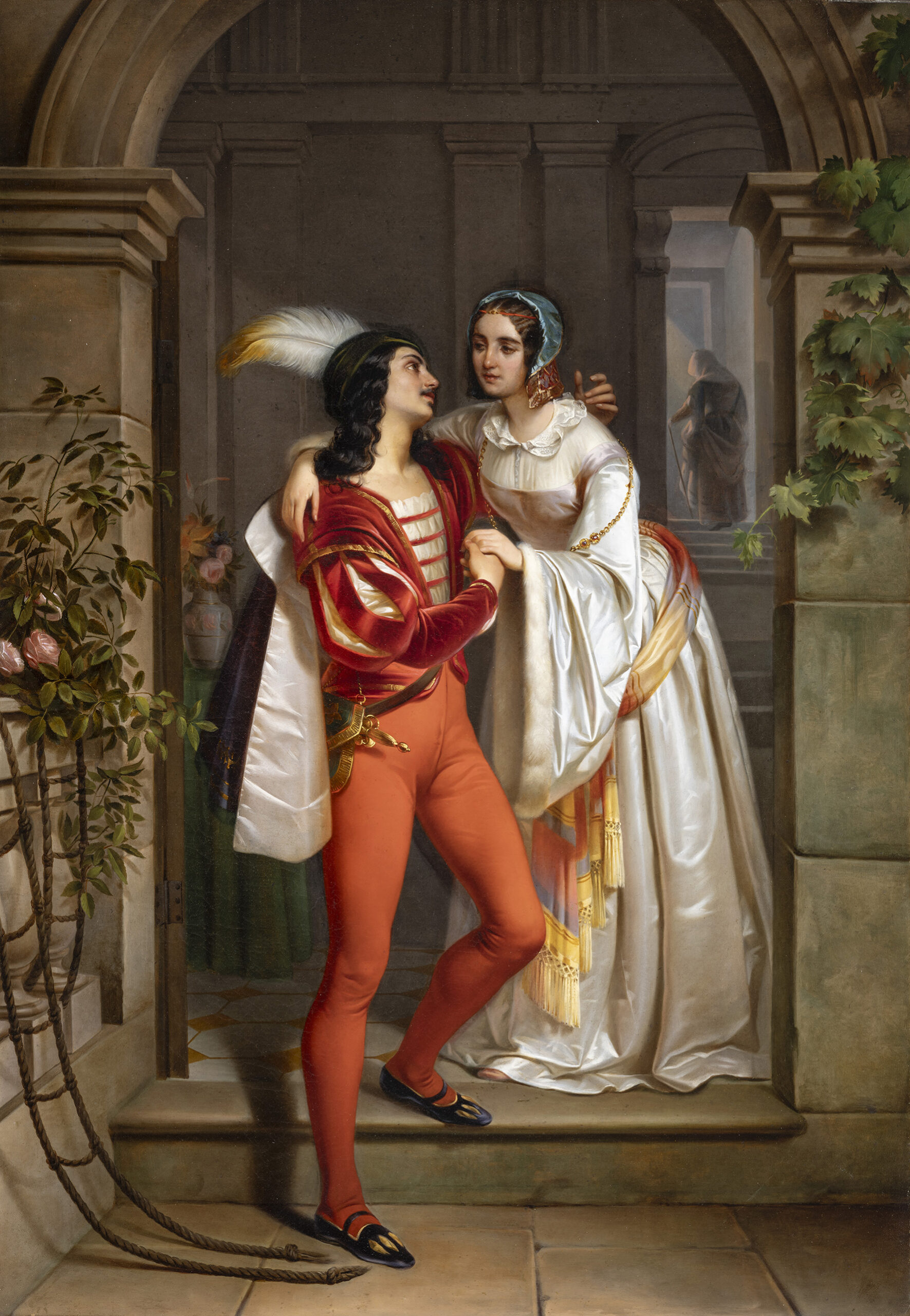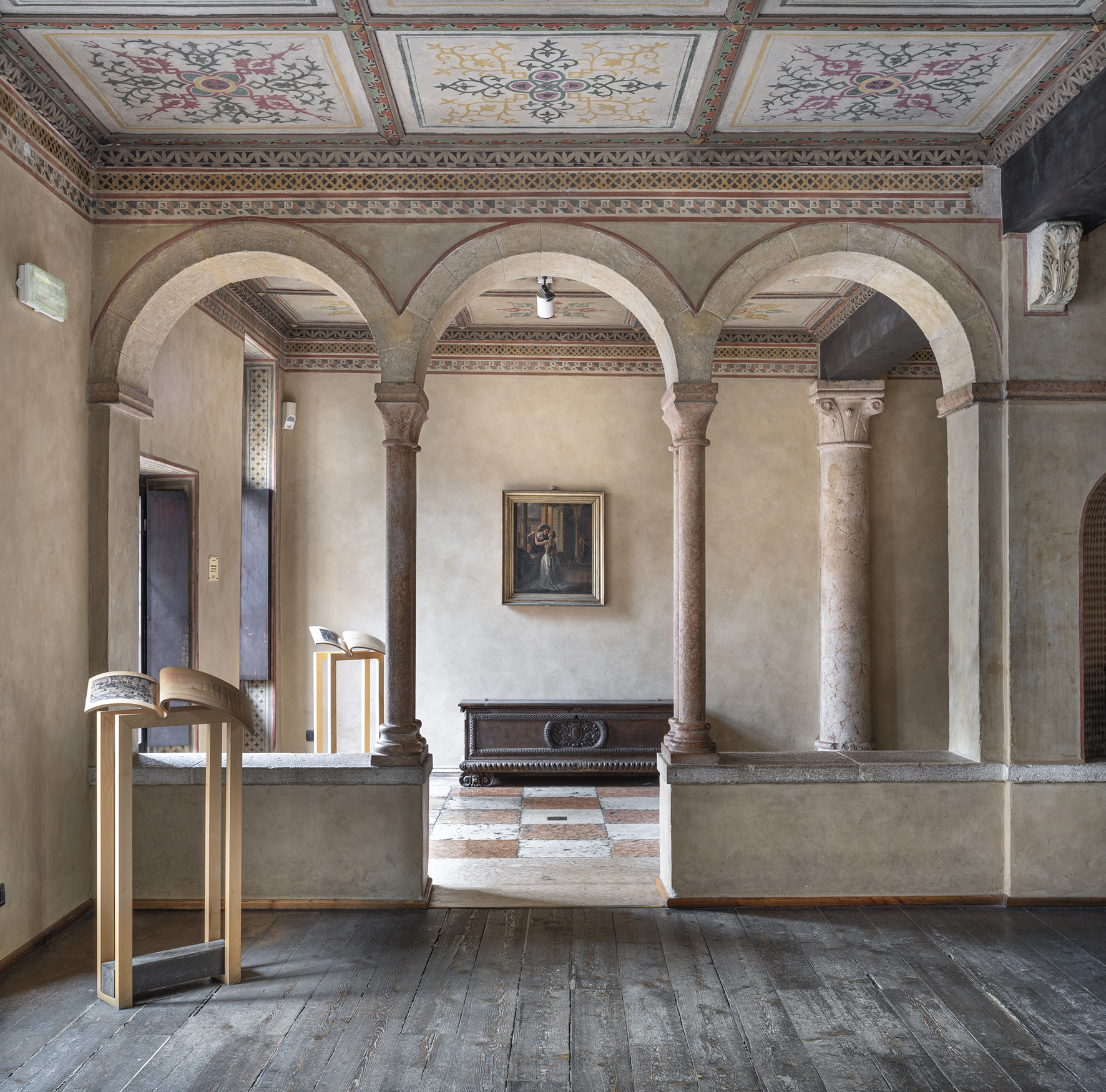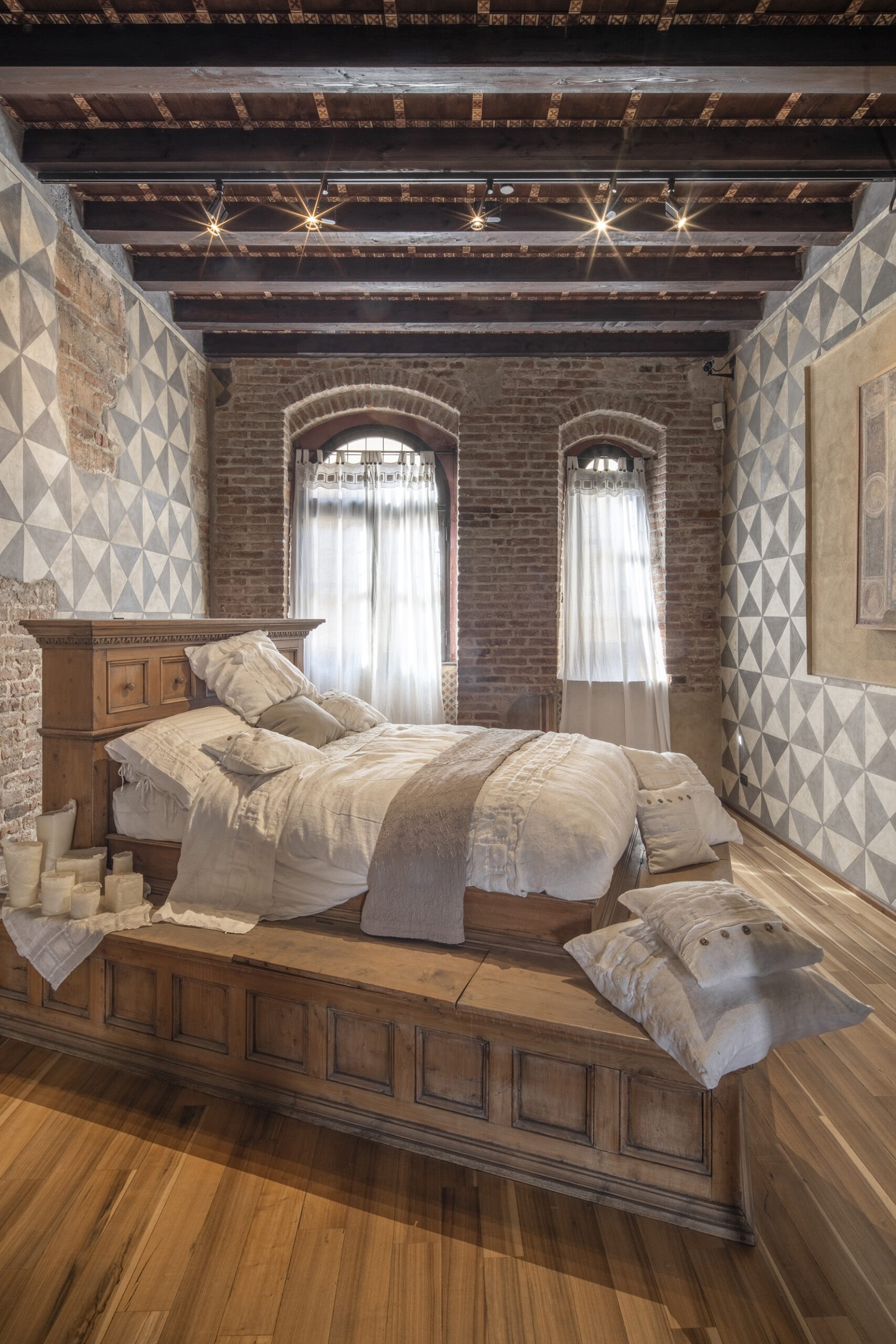
Cosroe Dusi, Giulietta e Romeo, 1838 ca. Olio su tela, cm 218 x 164. Casa di Giulietta, Musei Civici di Verona. Archivio Fotografico dei Musei Civici. Ph BAMSphoto
To witness the rediscovery of a work of art is always a great thrill, especially if it is a painting that had been missing for centuries. This is what happened at Juliet’s House in Verona, one of the most iconic places linked to the tragic love story between Romeo and Juliet.
A priceless artistic treasure has finally returned home: the 1838 painting of Romeo and Juliet by Cosroe Dusi, a work in which the Venetian painter depicted the sweet nocturnal encounter between the two lovers, a universal symbol of love and passion, in the house of the young Capulet.
Romeo and Juliet by Cosroe Dusi

Casa di Giulietta, Verona. Sala del Balcone. Archivio Fotografico dei Musei Civici. Ph BAMSphoto
After being considered lost for a long time, Cosroe Dusi’s painting of Romeo and Juliet has fortunately been tracked down and acquired thanks to a project to refurbish Juliet’s House.
This rediscovery not only enriches the cultural heritage of the city of Verona but also offers visitors an additional opportunity to immerse themselves in the most famous love story of all time by taking a closer look at the artistic expression of such a crucial moment narrated by Shakespeare.
The Return of Romeo and Juliet by Cosroe Dusi
Cosroe Dusi’s work “Juliet and Romeo,” dated 1838, returns to excite the public after being hidden from the eyes of the world for nearly two centuries. Its discovery and subsequent purchase place the painting in the permanent context of the Juliet House, contributing significantly to the enrichment of the cultural experience offered by the museum.
The eternal love story between Romeo and Juliet, already famous through Shakespeare’s words, finds a new visual dimension in this masterpiece, which captures the nocturnal encounter between the two lovers with timeless delicacy and intensity.
The Story Behind the Masterpiece
Cosroe Dusi, the artist behind this extraordinary painting, was a leading exponent of 19th-century Venetian painting. His style, influenced by Romanticism and the experience of artists such as Francesco Hayez, the famous author of the Brera Kiss, found in Shakespearean fiction a subject of profound inspiration.
The painting, commissioned by Count Francesco Gualdo of Vicenza, testifies not only to Dusi’s artistry but also to the continuing cultural relevance of the story of Romeo and Juliet, which spread from Verona throughout the world, influencing art, literature and theater.
Dusi’s painting is large (218 x 164 cm) and perfectly preserved.
It depicts Romeo embracing Juliet, turning a tender gaze on her in the intimate space of a balcony or loggia. The two lovers look sorrowful and are richly dressed.
The work is situated in the artistic maturity of Cosroe Dusi, who at the very time he was making it was updating his style by drawing inspiration from the works of Francesco Hayez, also invigorated by his newly achieved success as a portrait painter in Munich.
Dusi, in 1838, produced an exhibition at the halls of the Accademia in Venice to celebrate the visit of the Emperor of Austria, Ferdinand I, and on this occasion he exhibited seven works, including Juliet and Romeo, which became part of the patron’s collection of works soon after.
It was only after the collection was sold in the mid-19th century that the painting entered the antiques market and disappeared.
The story of Romeo and Juliet, from the pen of the Vicenza nobleman Luigi da Porto, was published as a novella in 1531. The Verona setting was probably inspired by Dante’s Divine Comedy where the Montagues, were really an ancient and noble Verona family, and the Cappellettis, a Guelph family from Cremona, were feuding with each other. The story became famous in Verona and then in France, until in England, in 1596, it was staged by William Shakespeare under the title “The Most Excellent and Lamentable Tragedy of Romeo and Juliet.”
Shakespeare was responsible for the universal fame of the story of Romeo and Juliet, which began to become an inspiration for artists. It was Francesco Hayez’s famous painting of Romeo and Juliet’s Last Kiss that inaugurated the popular fortunes of the subject in 1823, remaining, along with Dusi’s canvas, the most important large-scale figurative evidence of the two lovers in Italian painting of this era.
Cosroe Dusi’s painting of Juliet and Romeo experienced an extraordinary iconographic fortune and as early as 1841 appeared in an engraving taken from a drawing by Lilburne Hicks, an English illustrator who may have seen Dusi’s painting in Venice. The engraving was also used to accompany books and magazines and then circulated in postcard form in the early twentieth century.

Casa di Giulietta, Verona. Sala del Letto con il letto di Renzo Mongiardino (1968). Archivio Fotografico dei Musei Civici. Ph BAMSphoto
A Journey Through Culture and History
The painting, rediscovered by Professor Sergio Marinelli and also studied by Elena Lissoni and Fernando Mazzocca, returns to Verona at Juliet’s House, which boasts neo-medieval charm and is confirmed as a place of extraordinary historical and cultural importance.
There is no better place to host Dusi’s opera!
The proximity to the Teatro Nuovo and the connection to the Shakespearean sites of Verona offer visitors a unique journey, combining the beauty of visual art with the depth of literary tradition. The past and present meet, allowing anyone to approach the story of Romeo and Juliet in new and meaningful ways.
The rediscovery and permanent exhibition of Cosroe Dusi’s “Juliet and Romeo” in Juliet’s House represents a moment of cultural celebration for Verona and all those fascinated by the world’s best-known love story.

